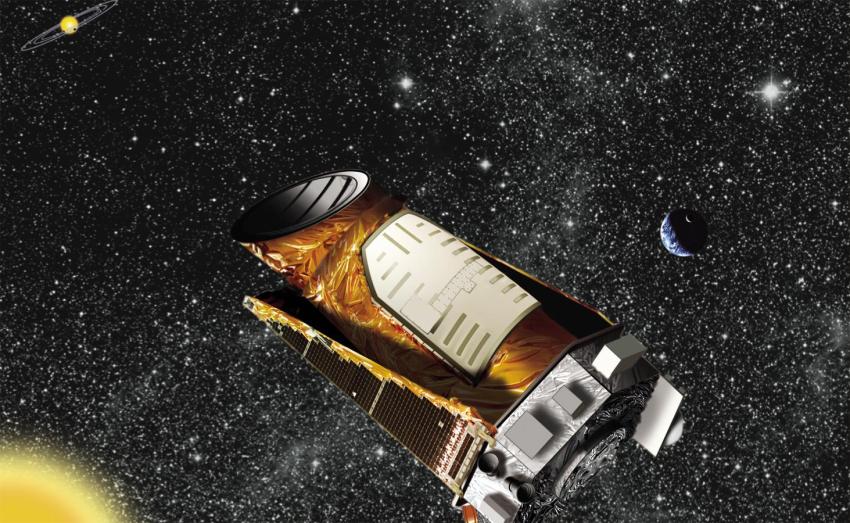Astronomers at the Massachusetts Institute of Technology and the University of Wisconsin at Madison, with the help of citizen scientists, have discovered the last three planets that the Kepler Space Telescope gazed upon before going dark. The research is published in Monthly Notices of the Royal Astronomical Society.
More than 5,000 planets are confirmed to exist beyond our solar system. Over half were discovered by NASA’s Kepler Space Telescope. Over nine and a half years, the spacecraft trailed the Earth, scanning the skies for periodic dips in starlight that could signal the presence of a planet crossing in front of its host star.
In its last days, the telescope kept recording the brightness of stars as it was running out of fuel. On 30 October 2018, its fuel tanks depleted, and the spacecraft was officially retired.
The team of astronomers, led by Professor Andrew Vanderburg and Elyse Incha, combed through the telescope’s last week of high-quality data and spotted three stars, in the same part of the sky, that appeared to dim briefly. The scientists determined that two of the stars each host a planet, while the third hosts a planet “candidate” that has yet to be verified.
The two validated planets are K2-416 b, a planet that is about 2.6 times the size of the Earth and that orbits its star about every 13 days, and K2-417 b, a slightly larger planet that is just over three times Earth’s size and that circles its star every 6.5 days. For their size and proximity to their stars, both planets are considered “hot
The planet candidate is EPIC 246251988 b — the largest of the three at almost four times the size of the Earth. This
Vanderburg and Incha presented the challenge to the Visual Survey Group, a team of amateur and professional astronomers who hunt for exoplanets in satellite data. They search by eye through thousands of recorded light curves of each star, looking for characteristic dips in brightness that signal a “transit,” or the possible crossing of a planet in front of its star.
The astronomers spent a few days efficiently looking through the light curves that Kepler recorded from about 33,000 stars. The team worked with only a week’s worth of high-quality data from the telescope before it began to lose fuel and focus. Even in this short window of data, the team was able to spot a single transit in three different stars.
Incha and Vanderburg then looked at the telescope’s very last, lower-quality observations, taken in its last 11 days of operation, to see if they could spot any additional transits in the same three stars — evidence that a planet was periodically circling its star.
This search revealed a second transit for K2-416 b and K2-417 b , validating that they each host a planet. The team also detected a similar dip in brightness for K2-417 b in data taken of the same star by NASA’s Transiting Exoplanet Survey Satellite (TESS), a mission that is led and operated by MIT. The data from TESS helped to confirm the planet candidate around this star.
“We have found what are probably the last planets ever discovered by Kepler, in data taken while the spacecraft was literally running on fumes,” says Professor Vanderburg. “The planets themselves are not particularly unusual, but their atypical discovery and historical importance makes them interesting.”
“Those two are pretty much without a doubt planets,” Incha says. “We also followed up with ground-based observations to rule out all kinds of false positive scenarios for them, including background star interference, and close-in stellar binaries.”
Media contacts
Gurjeet Kahlon
Royal Astronomical Society
Mob: +44 (0)7802 877700
press@ras.ac.uk
Dr Robert Massey
Royal Astronomical Society
Mob: +44 (0)7802 877699
press@ras.ac.uk
Science contacts
Professor Andrew Vanderburg
Massachusetts Institute of Technology
andrewv@mit.edu
Further information
The research appears in “Kepler's Last Planet Discoveries: Two New Planets and One Single-Transit Candidate from K2 Campaign 19”, Elyse Incha et al., Monthly Notices of the Royal Astronomical Society, in press.
This research was supported in part by MIT, NASA, and the University of Wisconsin Undergraduate Academic Awards.
Notes for editors
The Royal Astronomical Society (RAS), founded in 1820, encourages and promotes the study of astronomy, solar-system science, geophysics and closely related branches of science. The RAS organises scientific meetings, publishes international research and review journals, recognises outstanding achievements by the award of medals and prizes, maintains an extensive library, supports education through grants and outreach activities and represents UK astronomy nationally and internationally. Its more than 4,000 members (Fellows), a third based overseas, include scientific researchers in universities, observatories and laboratories as well as historians of astronomy and others.
The RAS accepts papers for its journals based on the principle of peer review, in which fellow experts on the editorial boards accept the paper as worth considering. The Society issues press releases based on a similar principle, but the organisations and scientists concerned have overall responsibility for their content.
Keep up with the RAS on Twitter, Facebook, Instagram, LinkedIn, and YouTube.


